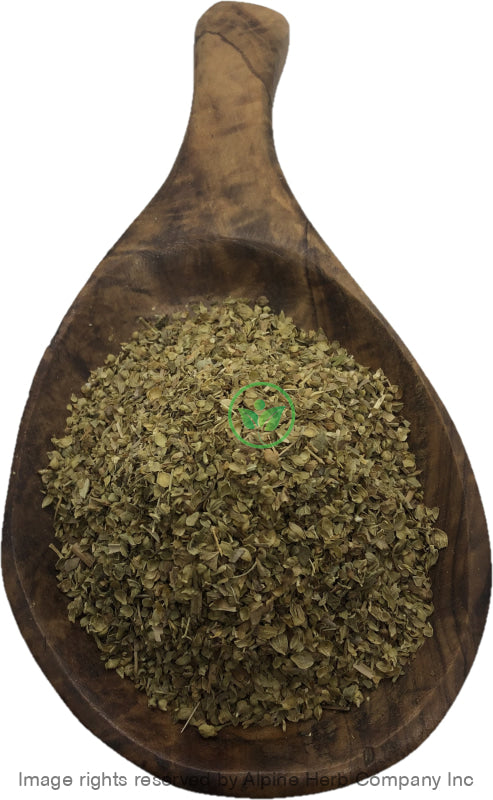Oregano Leaves Cut Alpine Herb Company Inc.
$ 7,99 $ 4,79
Botanical Name: Origanum vulgare
Common Name:
- English: Oregano, Wild marjoram
- Ayurvedic: Sukhaatmaka, Marubaka
- Unani: Marzanjosh.
- Also, known as: Oragan, Ordinara Origano, Oregano, Oregáno, Acciughero, Aitz Belarr, Anrar, Ào Lè Gāng, Ào Lè Gāng Cǎo, Avishan Kuhi, Bantulsi, Bergminta, Bergmynte, Brauner Dost, Brauner Dosten, Buklutulgezal, Ching Chieh, Marjolaine Bâtarde, Marazolette, Marijolai, Marjolaine Sauvage, Marjolaine Sauvage Origan, Common Marjoram, Dobromysl, Dost, Doste, Gewöhnlicher Dost, Hana-hakka, Hanahakka, Harilik Pune, Satar barri, Izmir kekigi, Ngou lahk gong, Ngauh ji, Ao le gang, Niu zhi, Ao le gang cao, Herba Origani, Jakhmbuti, Kaslók, Kekik Otu, Klopovnayatrava, Kostets, Kostolomnaya Trava, Kung, Kungsmynta, Lepiodkapospolita, Loragiño, Majurano Fero, Marzangush, Materynka, Materynka Zvichajna, Mountain Mint, Thym De Berger, Tograihon, Tost, Vadmajoránna, Vild Mejram, Wild Marjoram, Mravinac, Mäkimeirami, Ngàuh Ji, Ngou Lahk Gòng, Niu Zhi, Orégano, Oreganó, Oregánó, Orégão, Oregâos, Orenga, Organ, Oreganos, Organy, Origan, Origan Commun, Origan Vulgaire, Origano, Ourego, Paprastasis Raudonėlis, Pamajorán Obyčajný, Pelevoué, Penevoué, Pot Oregano, Raudenes, Remago, Rigan, Riegnu, Rigon I Egër, Rijan, Rigoni I Zakonshëm, Satar Barri, Sathra, Sovârf, Szurokfű, Tavshava, Thérouge, Wild Oregano, Wilde Marjolein, Wilder Majoran, Winter Marjoram, Wintersweet, Maruae, Santhraa, Jangali Maruaa, Oreganum, Sajivan, Sathra, Dziki majeranek, Lepiodka pospolita, Vild Mejram, Kungsmynta, Dosten, Duhov’i Tsvet, Dushita, Dushitsa, Dziki Majeranek, Echter Dost, Erba Acciuga, Fekete Gyopár, Frauendost, and Gemeiner Dost
Origin: Turkey
Harvested: Cultivated
Parts Used: Leaves
General Information:
Origanum vulgare, is a perennial herbaceous plant, which grows up to 100cm tall and 25cm wide. Genus name probably comes from the Greek words oros meaning mountain and gamos meaning beauty in reference to the physical appearance of this plant which is sometimes native of mountain areas where it is appropriately referred to as “beauty of the mountain”. The leaves are opposite, petiolate, long, oval and usually slightly toothed and are sweetly scented. Leaves are 10-40mm long and 5-20mm wide petiole hairy, about one fourth as long as the leaves, green on the top and paler underneath. Stems, erect, woody at the base, branched, quadrangular, hairy, often violet or purplish-green. Flowers, labiate type, generally bisexual, sometimes just female flowers with immature stigmas. The inflorescence is many-flowered, white to reddish purple in color, grouped into short dense lateral or terminal spikes. The corolla is white to purplish, 5-10 mm long, and has two lips. The calyx is five-toothed. Each flower has four stamens.
The white-flowered Greek form O. vulgare is the best for culinary use. The whole plant has a strong, peculiar, fragrant, balsamic odor and a warm, bitterish, aromatic taste, both of which properties are preserved when the herb is dry. Oregano is an important herb in Greek and Italian cuisine, the dried form having more flavour than the fresh leaves. To ensure that the flavor is retained, the dried product is not powdered but broken into small fragments. The flavor of oregano varies according to cultivar, environmental conditions and time of year. Perhaps the dish most widely associated with oregano is pizza. Oregano gives the classical pizza aroma, the pungent, thyme-like smell familiar to anyone who regularly eats Italian-style pizzas.
How to use:
As a spice.
Hot Infusion:
The basic method for dried herbs and flower is, take 2-3 tablespoons of dried herb in a cup or teapot. Pour hot water over it and cover it with lid for 10-30 minutes. Hot water is needed to draw out the antioxidants, enzymes, vitamins, flavonoids, and volatile oils from the botanicals. Strain and squeeze out as much as liquid as possible and enjoy!
Tips:
- You can sweeten your herbal tea with a bit of honey, natural fruit juice, stevia leaves powder and or licorice root powder.
- You can make ice cubes or pops by freezing tea in ice trays or pop molds.
Precautions:
You should consult with a qualified healthcare practitioner before using any herbal products, particularly if you are pregnant, nursing, or on any medications.
All information on this website is for educational purposes ONLY.
This information has not been evaluated by Health Canada.
This information is not intended to diagnose, treat, cure, or prevent any disease.
| Unit Size | 100g, 200g, 400g, 1kg |
|---|
Prompt shipping and expert packing
Thanks to our longstanding association with UPS FedEx DHL as well as other leading global carriers, we can offer a variety shipping options. Our warehouse staff is highly trained and will be able to pack your goods in accordance with our precise and exact specifications. Your items will go through an exhaustive examination before they will be securely packaged before being delivered. We ship to hundreds of thousands of customers daily in different countries. This is a sign of our determination to become the largest online retailer worldwide. Warehouses and distribution centers are located throughout Europe as well as in the USA.
Note that orders containing multiple items are processed according to the particular item.
We will thoroughly inspect all items ordered before shipping. Most orders are shipped within 48 hours. The delivery time will be between 3 and 7 working days.
Returns
The stock market is always changing. It's not entirely managed by us since we're involved with several entities, including the factory and the storage. Therefore, the actual inventory could fluctuate at any moment. Please be aware that it is possible that your order could be out of stock after you've placed your order.
Our policy lasts for 30 days. If it's been more than 30 days since the date you purchased your item We're sorry to say that we can't offer you a full exchange or refund.
You can only return a product if it is unused and still in the same state as when you received it. The item should be in the original packaging.


































